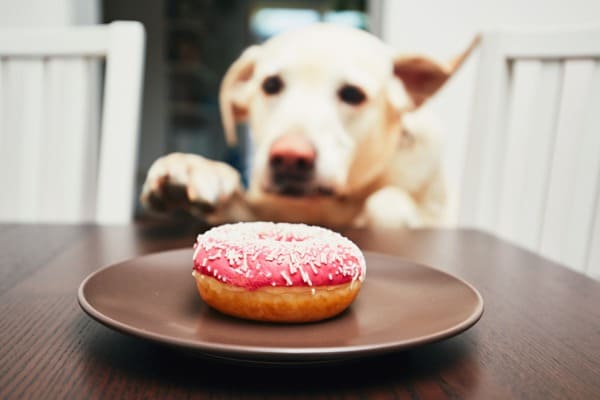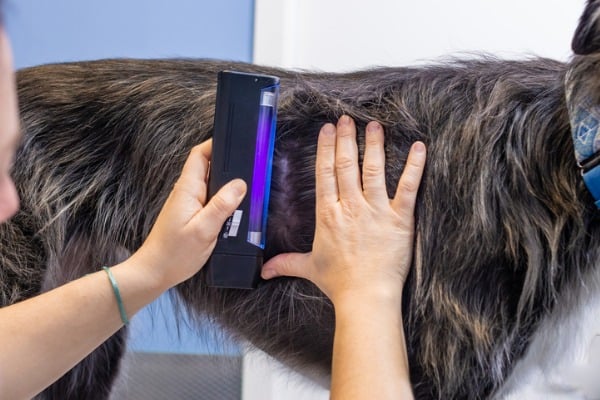“My dog can’t stop scratching – what now?”
Suddenly your dog can’t leave their mouth alone.
Something is bothering them, but what?
Itchiness and irritation can be incredibly frustrating to your dog because they can’t always relieve it by scratching.
Those paws aren’t as dexterous as human hands.
A dog with an issue with their mouth will usually rub their face on everything they can reach; your floors, your furniture, and even you.
There’s more:
A dog pawing at their mouth is another clue that something in there is bugging them.
A lot of things can cause your dog to fixate on their mouths, and they often have trouble settling down until the issue is addressed.
So what are some possible answers, and how can you fix them?
Read on:
To find out how to help your fur baby with this itchy nuisance.
1. Bad Eating Habits

It’s true that particular food sensitivities can cause allergic reactions in your dog, but we’re not talking about junk food just yet.
We’re talking about dogs who eat things that don’t even qualify as food.
If you have a dog with a liking for eating random things, you already know their palate doesn’t discriminate.
Clothes, sharp objects, sticks – they’re all on the table, literally.
There’s a medical term for this habit: pica. The condition is characterized by the consumption of non-food items – anything from rocks to textiles.
So what does that have to do with an itchy mouth?
Pica can offer a few explanations for a dog’s itchy mouth. If your dog eats everything under the sun, the answer could lie in several possibilities.
Connect with a verified veterinarian in minutes. No waiting for appointments or office hours. No high fees. Your pet's health made convenient and worry-free.
Foreign Objects
It can be risky if your dog eats anything and everything they can get their teeth on.
The risk is even higher if they get into something that is sharp or can become lodged in their gums or under their tongue.
What are some things to check your dog’s mouth for if they’re pawing at it?
Splinters from sticks, sewing needles or pins, tacks, fish hooks, and plastic, metal, or glass shards are things that could easily get stuck in their mouths.
What can you do when a foreign object is at play?
Removing anything sharp from your dog’s mouth is a tricky and sometimes dangerous task. You might get bitten – even accidentally.
The ideal scenario would be to take your dog to the vet, who will likely offer light sedation before carefully extracting the object.
To pull a sharp object out at home, you must first be sure it’s not deep or wedged in.
Fish hooks, for example:
Are something we do not recommend removing at home. You can cause further pain and damage if you’re dealing with something more complicated than a splinter or sewing pin.
You also need to be confident your dog won’t fight you to the point they injure themselves or you. Some dogs will allow trusted humans to help, while others will resist.
Most importantly of all:
You must be sure you can safely remove the object without putting your dog at risk of choking.
A dog who is struggling might end up swallowing a small object, which can then become lodged deeper in the throat, obstruct airways, or move to the stomach, where it becomes an even bigger problem.
For these reasons:
We strongly recommend anything large or stuck deep in the mouth be handled by a vet.
Contact Dermatitis

Eating clothes, blankets, or anything else that regularly sees a washing machine can give your dog a case of contact dermatitis.
This condition is triggered when your dog comes into contact with something that irritates them.
Allergens are a big part of the problem, but so are cleaning substances like laundry detergent.
A dog scratching their muzzle could have an itchy mouth because of the socks they ate for dessert.
Some pups will go so far as to eat dryer sheets, which can be even more irritating.
The best way to get a handle on this issue is to deal with the unusual eating habits first.
Some dogs with severe reactions can benefit from medications under a vet’s supervision.
Prickly or Poisonous Plants
Eating plants doesn’t necessarily fall under the condition of pica, as many dogs enjoy eating plants but not other non-food objects.
If you live in a region where poison ivy, oak, or sumac grow, there’s a possibility your dog got a hold of one of these irritating plants.
Luckily:
It’s unusual for dogs to react to poison ivy and other itch-inducing plants.
Eating one of the plants or even licking on is one of the ways a dog can be exposed and show evident signs of irritation.
If you suspect your dog has come into contact with poison ivy, oak, or sumac, you’ll want to bathe them to protect yourself from exposure.
Your dog’s fur is the perfect transport for the oils responsible for unbearable itching.
Signs of irritation in the mouth should be evaluated by a vet, who might recommend medication to make your dog more comfortable as they heal.
Itchy leaves aren’t the only danger in the plant world.
Living in areas where cacti grow present a risk of your dog coming into contact with one.
Or, you might have one in your home that your dog got a little too curious about.
A friendly reminder to pet parents:
Look at the highest shelf or surface you think your dog can reach.
Now, put all hazardous plants a few extra feet above that – dogs have a way of reaching things up high.
A dog scratching their muzzle could have cactus spines on the outside of their mouths.
They might also have some stuck on the inside.
If your dog bumped a cactus and the spines are stuck on the outside, you might be able to take care of them at home.
If there are just a few, tweezers will usually do the trick.
The faster you can deal with this issue, the better.
A dog with cactus spines on their mouth or face area will rub at them, sometimes driving them deeper into the skin.
If you can’t see the spines, it could be glochids that are bothering your dog.
Glochids are fine, hair-like, hard to see, and incredibly irritating – similar to fiberglass.
One way you can try to remove glochids from your dog is to run nylon stockings over the area – the fibers can grab ahold of the glochids and pull them out.
Sometimes:
Only a magnifying glass, tweezers, and a very still dog will do the trick – something the vet can help out with.
A large amount of spines is better dealt with at the vet – the more spines, the more pain your dog will experience.
The painkillers and mild sedation available at the vet will make the situation less stressful for everyone involved.
2. Allergies

Your dog’s itchy mouth could be the result of food allergies or sensitivities.
Wheat and beef are two common food allergens in dogs, so it’s a good idea to become familiar with dog food labels.
If your dog is scratching their mouth after a change in diet, it might be necessary to switch back to their old food or try a different one.
Elimination diets can help determine what exactly doesn’t agree with your dog’s system.
Dogs with food allergies often display other symptoms, such as itchy ears, hot spots on the skin, and intestinal problems.
A bad diet all around can also raise some issues.
Junk food, too much starch, and sharing table scraps can trigger a fatty acid imbalance in your dog’s body, leading to irritation of the skin.
3. Parasites

Fleas would much rather take up residence in your dog’s fur than inside their mouth. However, they can bite around the muzzle and cause itchiness.
A dog scratching their mouth could have a flea problem.
Dogs with long hair around the muzzle and face are more likely to be bitten in that area, as it makes the perfect stomping grounds for those nasty bugs.
The only way to solve this problem is to eliminate the flea infestation.
Flea baths and anti-parasitic medications are usually needed to kill the fleas on your dog.
You’ll also need to look into flea foggers for your home.
There is another pest that will burrow in your dog’s mouth if given a chance. Ticks can embed themselves between your dog’s teeth and gums or under the lips.
If you also see your dog licking its lips and swallowing, this is worth checking out.
So ask yourself:
Is my dog on parasite preventives?
If the answer is no, and your dog can’t stop scratching at their mouth, it’s time to take a peek for a tick.
Removing a tick from the gums isn’t as risky as removing a sharp object. The issue lies in your dog’s cooperation – or lack thereof.
The crucial thing regarding tick removal is to get the whole thing – sometimes, the body can detach from the head, which remains embedded in the skin or gums.
Pull with a pair of fine-point tweezers in a firm, upward motion.
If you’re concerned about tick-borne illnesses, save the tick in a secure container for the vet to inspect.
The good news is that the diseases carried by ticks are unlikely to be transmitted to your dog if you remove them within 24 hours.
If your dog is an outdoor enthusiast, check for ticks often.
A tick inside the mouth can be very annoying to your dog, so they might let you know there’s one bothering them before you have a chance to check.
Excessive licking and pawing at the mouth can indicate a tick is trying to invade your dog’s gums.
It’s essential to remember that many types of bug bites can irritate your dog.
Dog snouts frequently have less hair than elsewhere on the body, and the skin is thinner, making it a sensitive area to be bitten.
A mosquito bite on the chops, for example, is enough to cause your dog to scratch at their face until the bite goes down.
A bee sting is another irritant that might cause your dog to paw at their mouth.
Swelling of the area is another clue that your dog has been bitten or stung by an insect – the mouth area is extra susceptible to swelling after a bee or ant sting.
4. Nervous Habits
Ticks in the mouth can cause your dog to scratch their mouth.
Nervous tics can produce similar results.
Some dogs scratch out of anxiety or boredom.
They could scratch anywhere or fixate on their face.
Nervous scratching can look like your dog constantly wiping their face, digging at their mouth with their back paws, and wiping or dragging their mouth and face all over everything.
Separation anxiety is one cause of nervous scratching, as well as anxiety due to loud noises such as thunderstorms.
Any significant disruption in your dog’s lifestyle can trigger anxiety, as well.
Traveling, guesting family members, a new house, or a new pet are enough to stress out some dogs.
What if the cause is boredom?
Bored dogs have a lot of destructive or inconvenient habits – but it’s not their fault.
A bored dog should have their routine reevaluated – starting from how much time they have to spend left to their own devices versus how much exercise they get.
Being left on their own isn’t the end of the world:
Especially when most of us work long days most of the week.
The key is balancing out the boredom with plenty of exercise, socialization, and fun activities.
Aside from providing more enrichment for your dog, you can try to shift their fixation with their mouth to something less bothersome.
Try giving them safe chew toys or interactive dog toys that take their mind off their mouth.
Ditch That Itch
A dog red around the mouth and itchy has something unusual going on. Fortunately, the most likely culprits aren’t anything life-threatening or serious.
It will take some evaluation on your part to figure out what is bothering them, and sometimes a vet will need to step in.
However:
There are plenty of solutions, no matter what the underlying cause of your dog’s itchy mouth.
Remember:
Exercise caution when you take a peek into the gaping maw – even accidental bites and nips can happen to the best of us.

